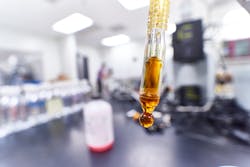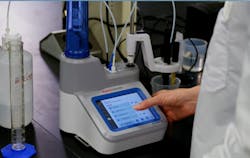Advanced titration technology ensures drinking water quality and safety
By Andrea F. Gullà
The quality and safety of drinking water are of paramount importance for the wellbeing of populations worldwide. In order to maintain a secure supply of drinking water, reliable testing of key variables is necessary to support treatment and decontamination processes.
The ability to monitor pH is fundamental in assessing water quality and it is widely recognized as one of the most important parameters for drinking water quality and safety. Either low or high pH levels can be an early indicator of chemical or heavy metal pollution; an unexpected pH value can trigger further testing to identify the source of pollution.
To safeguard community health, regulatory bodies in the United States and Europe mandate minimum and maximum acceptable pH levels, requiring careful monitoring of this crucial value. However, it can be particularly challenging to achieve reliable pH measurements with complex water matrices. In response, advanced ion-selective electrode titration technology is enabling consistent and accurate measurements of pH to be performed in the laboratory, field and online, regardless of sample complexity, to facilitate access to safe, regulatory-compliant drinking water.
The Key Role of pH
Drinking water pH is a key indicator not only of the solubility of chemicals (the amount that can be dissolved in water) but also of the bioavailability of elements that can be beneficial to sustaining life or prove harmful if they exceed certain limits, such as nutrients (phosphorus, nitrogen and carbon) and heavy metals (lead, copper, cadmium, etc.). Common sources of contamination detected by pH monitoring include but are not limited to: animal and human waste, pesticide use, the improper disposal of chemicals, and the deep earth injection of hazardous materials.
A change in the pH of water can also have repercussions on the behavior of other chemicals present in water. For instance, ammonia is harmless to fish in slightly acidic water but, as pH increases, ammonia becomes toxic and can severely affect aquatic life. In the case of heavy metals, the degree to which they are soluble determines their toxicity. Metals tend to be more toxic at lower pH levels because they are more soluble.
For municipalities and management facilities, adequate control of the pH of water becomes crucial to safeguarding the quality and usability of our waterways. Cities and municipalities with aging infrastructure may add orthophosphate as part of efforts aimed at preventing corrosion. For others, treating water to achieve a high pH and high alkalinity decreases the solubility of lead carbonates, which also contribute to the protective mineral layer of pipes. Industrialization further increases the necessity to constantly monitor and control the pH of our water supplies in response to the impact of acidic rain generated by sulfuric acid (produced by coal-burning industries) and nitric acid (produced by internal combustion engines).
Acidic water (with a pH less than 6.5) is more likely to be contaminated with heavy metals, and therefore unsafe for consumption. Alkaline water (with a pH greater than 9.5), on the other hand, may be safe for human consumption but can have an unpleasant smell or taste.
The Challenges of Measuring the pH of Drinking Water
In the U.S., the Environmental Protection Agency’s Safe Drinking Water Act specifies that the pH of drinking water should be between 6.5 and 8.5. In Europe, the Drinking Water Directive (Council Directive 98/83/EC) requires pH levels to fall between 6.5 and 9.5.
Beyond protecting public health and complying with regulatory requirements, water treatment facilities face further challenges associated with pH monitoring. The greatest obstacle is the ever-increasing complexity of the chemistry of water due to an array of hazardous materials, such as byproducts from chemotherapeutic processes, finding their way into the water supply. This makes it much more difficult for conventional analytical technologies to separate pH from the other elements present in the matrix and thereby provide accurate measurements.
Additionally, water treatment facilities must perform pH measurements throughout the treatment process. When hydrogen ion concentration is higher than that allowed by regulations, the water is normalized and retested. Depending on the size of the facility, pH monitoring may be done online or outsourced to an independent testing service. In the first case, facilities can benefit from real-time results, which allows for immediate corrective action to be taken when limits are exceeded. However, knowledgeable and experienced personnel are required to undertake the analysis. On the other hand, an external provider offers the necessary level of expertise but results may take longer to be delivered, thus interrupting the treatment process.
Regardless of when and where pH measurements are performed, analytical technologies need to provide results accurately, reliably and efficiently to ensure drinking water is of the desired quality and in line with the latest regulatory requirements.
Using Advanced Titration Technologies
Ion-selective electrodes (ISEs) — the oldest class of chemical sensors — provide a superior pH measurement technology that is widely used across a broad range of applications, including in biomedical, industrial, and environmental sectors. In contrast to other analytical methods, ISEs respond to the activity and not simply the concentration of ions. With billions of measurements performed each year in water management facilities all over the world, ISE technology helps ensure the safety and quality of global water supplies.
The technology offers analysts the ability to differentiate between ions (Na+, K+, Cl-, Ca2+ and H+) present in a water sample and provides a quantitative analysis to determine their concentration. When a pH-sensing electrode comes in contact with a sample, a potential develops across the device’s membrane surface and that membrane potential varies with pH. A reference electrode provides a second, unvarying potential to quantitatively compare with the changes of the sensing membrane potential and to identify critical deviations from the regulated limits.
While miniaturization of ISE technology has been elusive and unpredictable, developments have primarily focused on eliminating the liquid internal filling solution generally used in conventional benchtop ISEs. This has been achieved by using hydrogels doped with appropriate salt and through advanced internal membrane technology. The membrane interface is crucial to the proper functionality of ISEs, as this manages the charge transfer between the salt contained in the electrolyte and the Ag/AgCl reference electrode. Selective composite membranes, used most successfully in contact with solutions on both sides of the membrane, are the active components in many selective potentiometric sensors and safeguard both the accuracy and precision of the instrument.
However, as the chemical complexity of water samples increases, it becomes more challenging for the electrodes to differentiate between ions. In response, developments in modern electrode technology — such as glass and crystal ion membrane technologies, ion exchange resin membranes, and enzyme-based electrodes — are facilitating the reliable separation and measurement of pH (and other ions) even in very complex matrices. Conducting polymers (i.e., electroactive conjugated polymers) are also useful both as ion-to-electron transducers and as sensing membranes in solid-state ISEs. Recent achievements over the last few years have resulted in significant improvement in the analytical performance of solid-contact ISEs, driven by the use of conducting polymers as ion-to-electron transducers combined with polymeric ion-selective membranes.
Additionally, by combining advanced membrane technologies with a range of automation features, the latest ion-selective electrodes also simplify the testing of drinking water pH, deliver accurate and reproducible results, and increase productivity. Furthermore, these innovative technologies are enabling users to measure a multitude of other elements in the same sample, including total ammonia, total nitrogen, total fluoride, and total chlorine, offering an all-inclusive solution that can help to streamline testing procedures.
Conclusion
Monitoring the pH of drinking water is necessary to ensure it is of the highest quality and meets rigorous regulatory requirements. Equipped with advanced membrane technologies and automation features, modern state-of-the-art ion-selective electrodes allow water treatment facilities to utilize the full power of titration methods to more accurately and efficiently determine the pH of drinking water and verify whether it is fit for use. WW





